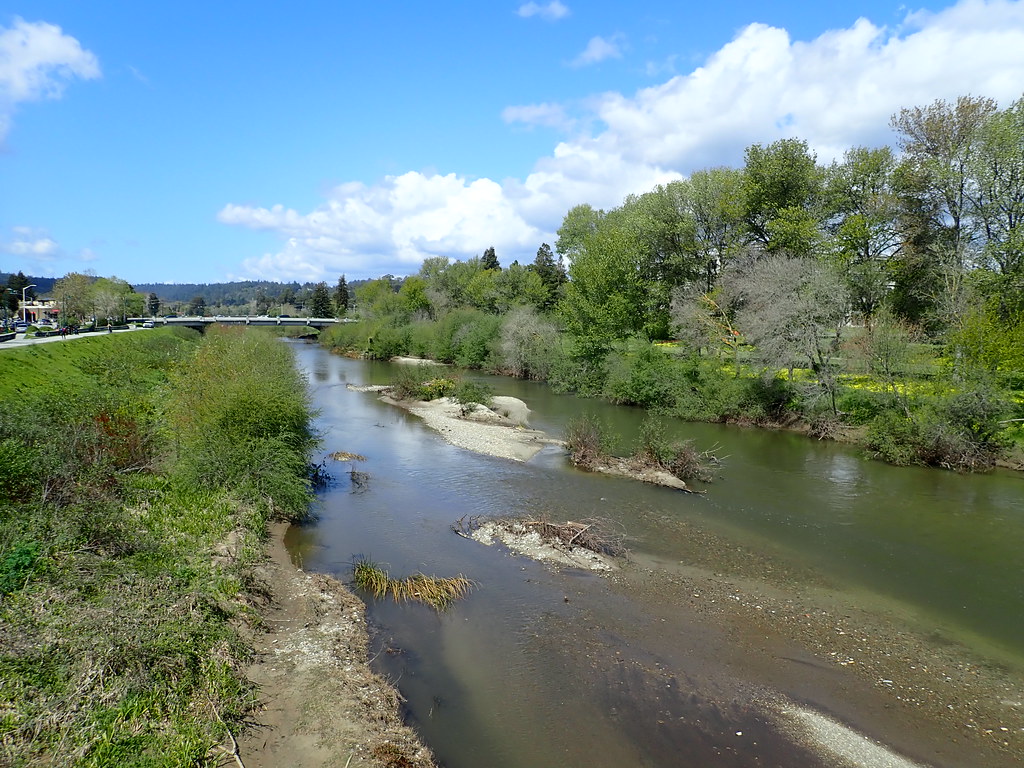
Your Source for Outdoor Adventure
Northern California and Southern Oregon
Coastal Conference: The Upcoming 38th Salmonid Restoration Federation Meeting in Santa Cruz

San Lorenzo River
Photo Credit: Courtesy of FIshBio
by FISHBIO
1-20-2020
Tumbling their way through the redwoods, the streams of California’s Central Coast provide valuable habitat for those salmon and trout tenacious enough to contend with seasonal lagoons, the steep gradients of coastal mountains, and the effects of increasingly urbanized watersheds. The challenges facing fish that have persisted in these streams, such as steelhead (Oncorhynchus mykiss) and coho salmon (O. kisutch), will be highlighted at the upcoming 38th annual Salmonid Restoration Federation conference. To be held from March 31 to April 3 within sight of the San Lorenzo River in the heart of Santa Cruz, this conference will bring together researchers and managers from academic institutions, government agencies, non-profit organizations, and private companies to exchange ideas, discuss successes and failures, and to learn about the state of salmon recovery in California.
Coastal streams present many unique challenges and opportunities for salmonid recovery. Shifting sands, turbid water, and dramatic seasonal changes in flow make it exceptionally difficult to monitor salmon and steelhead inhabiting coastal streams. Without reliable data on these populations, it can be difficult for managers to determine the best course of action for conservation and recovery. However, in tackling the task of salmonid monitoring in these difficult systems over the years, fisheries professionals have gained insight into best practices and have developed new equipment to weather tumultuous conditions. To share the insights and innovations gained through both frustrating failures and remarkable successes, FISHBIO will be hosting a session at the conference on Friday, April 3, that focuses on innovations to address the challenges of salmonid monitoring in coastal streams. Experts will discuss developing PIT tag antennas robust enough to tolerate fluctuating flows, using sound to see through muddy waters, and searching for DNA in the environment to detect otherwise hidden species. Ten additional presentation sessions and a poster session will cover a wide range of topics from the management of coastal lagoons and urban streams, to seascape ecology and dam removal.
On Tuesday, March 31, and Wednesday, April 1, conference attendees will also have the opportunity to participate in full-day workshops, including sessions on fish passage design for road crossings, assessing the ecological risk of streamflow diversions, accelerating coho and steelhead recovery, and even leveraging the natural activities of beavers to help restore salmon habitat. Several concurrent field tours will allow interested participants to get their boots on the ground – or in the water – and see firsthand the effects of ongoing recovery efforts in the region, including fish passage projects at Los Padres Dam and the San Clemente Dam removal and floodplain restoration site on the Carmel River, coho recovery work in nearby Scotts Creek, and salmonid recovery projects in Santa Cruz’s own San Lorenzo River. This conference promises to provide valuable insight into technical, biological, and policy-related salmonid and watershed restoration. Watershed scientists, restoration practitioners, fisheries biologists, resource agency personnel, and students of related disciplines are all encouraged to attend. Advanced registration is open through February 21, but the conference is expected to sell out, so anyone interested in attending should register soon. We hope to see you soon in Santa Cruz!
FISHBIO is a dedicated group of research scientists, engineers, and technicians that specialize in counting, tracking, and analyzing trends in fish and wildlife populations throughout the world. An expert staff, technical capacity, and state-of-the-art equipment make FISHBIO a trailblazer in aquatic research. For more information, please visit FISHBIO.com
MyOutdoorBuddy.com © 2024. All Rights Reserved.
Website Hosting and Design provided by TECK.net
Website Hosting and Design provided by TECK.net